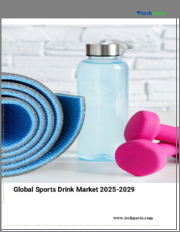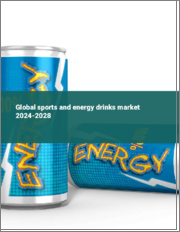
|
시장보고서
상품코드
1610691
스포츠 드링크 시장 규모, 점유율, 성장 분석 : 유형별, 형태별, 브랜드별, 포장 유형별, 유통 채널별, 지역별 - 산업 예측(2024-2031년)Sports Drink Market Size, Share, Growth Analysis, By Type(Isotonic, Hypotonic, Hypertonic), By Form, By Brands, By Packaging Type, By Distribution Channel, By Region - Industry Forecast 2024-2031 |
||||||
세계의 스포츠 드링크 시장 규모는 2022년에 257억 5,000만 달러로 평가되며, 2023년 268억 2,000만 달러에서 2031년에는 368억 9,000만 달러로 성장하며, 예측 기간(2024-2031년)의 CAGR은 4.08%로 성장할 전망입니다.
COVID-19 팬데믹은 전 세계에서 스포츠 음료에 대한 수요가 전례 없는 급증을 불러일으켰고, 2019년 스포츠 음료 시장은 전년 대비 7.7%의 놀라운 성장을 이루었습니다. 주로 운동선수들의 효과적인 수분 보충을 돕기 위해 고안된 스포츠 음료는 필수 탄수화물, 미네랄, 전해질을 함유하고 있으며, 운동능력과 회복력을 향상시킵니다. 그 매력은 피트니스 활동과 마라톤 참여에 대한 인기가 높아지면서 마케팅의 초점이 엄격한 운동 선수에서 일반 소비자층으로 이동하고 있습니다. 특히 신흥 시장에서의 운동선수 증가와 식습관을 변화시키는 도시화를 선호하는 뚜렷한 인구 추세로 인해 이 분야의 확장은 더욱 가속화되고 있습니다. 성능과 체력에 대한 관심이 높아짐에 따라 스포츠 음료는 치열한 신체 활동을 하는 사람들에게 필수적인 음료가 되고 있습니다.
목차
서론
- 조사의 목적
- 조사 범위
- 정의
조사 방법
- 정보 조달
- 2차 데이터와 1차 데이터 방법
- 시장 규모 예측
- 시장의 전제조건과 제한
개요
- 세계 시장 전망
- 공급과 수요 동향 분석
- 부문별 기회 분석
시장 역학과 전망
- 시장 개요
- 시장 규모
- 시장 역학
- 촉진요인과 기회
- 억제요인과 과제
- Porter의 산업 분석과 영향
- 경쟁 기업 간 경쟁 관계
- 대체품의 위협
- 바이어의 교섭력
- 신규 진출업체의 위협
- 공급 기업의 교섭력
주요 시장 인사이트
- 주요 성공 요인
- 경쟁의 정도
- 주요 투자 기회
- 시장 에코시스템
- 시장의 매력 지수(2023년)
- PESTEL 분석
- 거시경제 지표
- 밸류체인 분석
- 가격 분석
- 기술의 진보
- 규제 상황
- 사례 연구
스포츠 드링크 시장 규모 : 유형별 & CAGR(2024-2031)
- 아이소토닉
- 하이포토닉
- 하이퍼토닉
스포츠 드링크 시장 규모 : 형태별 & CAGR(2024-2031)
- 액체
- 분말
스포츠 드링크 시장 규모 : 브랜드별 & CAGR(2024-2031)
- 게토레이드
- 파워에이드
- 기타
스포츠 드링크 시장 규모 : 포장 유형별 & CAGR(2024-2031)
- 금속
- PET/플라스틱
- 유리
스포츠 드링크 시장 규모 : 유통 채널별 & CAGR(2024-2031)
- 오프라인 채널
- 온라인 채널
스포츠 드링크 시장 규모 : 지역별 & CAGR(2024-2031)
- 북미
- 미국
- 캐나다
- 유럽
- 영국
- 독일
- 스페인
- 프랑스
- 이탈리아
- 기타 유럽 지역
- 아시아태평양
- 중국
- 인도
- 일본
- 한국
- 기타 아시아태평양
- 라틴아메리카
- 브라질
- 기타 라틴아메리카 지역
- 중동 및 아프리카
- GCC 국가
- 남아프리카공화국
- 기타 중동 및 아프리카
경쟁 정보
- 상위 5사의 비교
- 주요 기업의 시장 포지셔닝(2023년)
- 주요 시장 기업이 채택한 전략
- 시장의 최근 동향
- 기업의 시장 점유율 분석(2023년)
- 주요 기업의 기업 개요
- 회사 개요
- 제품 포트폴리오 분석
- 부문별 점유율 분석
- 매출의 전년대비 비교(2021-2023)
주요 기업 개요
- PepsiCo
- The Coca-Cola Company
- Danone S.A.
- Abbott.
- AJE Group
- Monster Energy Company
- Congo Brands
- Otsuka Pharmaceutical Co., Ltd.
- Fraser & Neave Holdings Bhd
- Red Bull GMBH
- Nestle S.A.
- FRS Healthy Energy
- Swire Group
- Suntory
결론과 권장사항
KSA 24.12.19Global Sports Drink Market size was valued at USD 25.75 billion in 2022 and is poised to grow from USD 26.82 billion in 2023 to USD 36.89 billion by 2031, growing at a CAGR of 4.08% in the forecast period (2024-2031).
The COVID-19 pandemic has sparked an unprecedented surge in the global demand for sports drinks, leading to a remarkable market growth of 7.7% in 2019 compared to prior years. Primarily designed to help athletes hydrate effectively, sports drinks contain essential carbs, minerals, and electrolytes, enhancing performance and recovery. Their appeal has broadened significantly, shifting marketing focus from strictly athletes to the general consumer base, fueled by the rising popularity of fitness activities and marathon participation. This sector's expansion is further bolstered by an increasing number of athletes, particularly in emerging markets, and a notable demographic trend favoring urbanization, which alters dietary habits. With the growing emphasis on performance and stamina, sports drinks are becoming essential for those engaged in rigorous physical activities.
Top-down and bottom-up approaches were used to estimate and validate the size of the Global Sports Drink market and to estimate the size of various other dependent submarkets. The research methodology used to estimate the market size includes the following details: The key players in the market were identified through secondary research, and their market shares in the respective regions were determined through primary and secondary research. This entire procedure includes the study of the annual and financial reports of the top market players and extensive interviews for key insights from industry leaders such as CEOs, VPs, directors, and marketing executives. All percentage shares split, and breakdowns were determined using secondary sources and verified through Primary sources. All possible parameters that affect the markets covered in this research study have been accounted for, viewed in extensive detail, verified through primary research, and analyzed to get the final quantitative and qualitative data.
Global Sports Drink Market Segmental Analysis
Global Sports Drink Market is segmented by Type, by Form, by Brands, by Packaging Type, by Distribution Channel and by Region. Based on Type, the market is segmented into Isotonic, Hypotonic, Hypertonic. Based on Form, the market is segmented into Liquid, Powder. Based on Brands, the market is segmented into Gatorade, Powerade, Others. Based on Packaging Type, the market is segmented into automotive, consumer electronics, healthcare, agriculture, manufacturing, and others. Based on Distribution Channel, the market is segmented into Based on region, the market is segmented into North America, Europe, Asia Pacific, Latin America and Middle East & and Africa.
Driver of the Global Sports Drink Market
The Global Sports Drink market is significantly driven by an increasing inclination among millennials toward physical fitness activities, coupled with their higher disposable income and readiness to invest in healthier options. The advantages of sports drinks, such as mitigating dehydration, replenishing lost electrolytes from sweat, and maintaining the body's electrolyte equilibrium, are becoming more widely recognized among consumers, further propelling demand. Additionally, manufacturers are focusing on innovation, launching a variety of organic drinks that cater to health-conscious consumers, thus enhancing revenue potential for businesses. For example, Powerade's introduction of its new zero-sugar formulas and the POWERADE ULTRA variant, enriched with electrolytes and amino acids, exemplifies how companies are expanding their product offerings to meet consumer needs, driving market growth.
Restraints in the Global Sports Drink Market
One significant restraint facing the global sports drink market is the prevalent high sugar content in many products, which raises health concerns among consumers. This excessive sugar can contribute to various health issues, deterring health-conscious individuals from purchasing these beverages. For example, popular sports drinks like Gatorade contain approximately 34 grams of sugar in a 20-ounce bottle, highlighting the issue. Such nutritional drawbacks are limiting the market's potential for growth, as more consumers seek healthier, lower-sugar alternatives. As awareness of health and wellness continues to rise, the industry must adapt to meet these changing consumer preferences for better options.
Market Trends of the Global Sports Drink Market
The Global Sports Drink market is witnessing a significant shift towards products featuring natural ingredients, driven by a consumer preference for healthier alternatives to traditional formulations. This trend offers vast expansion opportunities, as seen in the introduction of innovative products like Good Sports, a Chicago-based startup that launched a natural sports drink with 97% dairy content, boasting three times the electrolytes and 33% less sugar than conventional options. Furthermore, increasing health consciousness among populations in developing and underdeveloped regions is further propelling market growth. As consumers prioritize wellness and hydration, brands focusing on natural and functional ingredients are poised to gain a competitive edge.
Table of Contents
Introduction
- Objectives of the Study
- Scope of the Report
- Definitions
Research Methodology
- Information Procurement
- Secondary & Primary Data Methods
- Market Size Estimation
- Market Assumptions & Limitations
Executive Summary
- Global Market Outlook
- Supply & Demand Trend Analysis
- Segmental Opportunity Analysis
Market Dynamics & Outlook
- Market Overview
- Market Size
- Market Dynamics
- Driver & Opportunities
- Restraints & Challenges
- Porters Analysis & Impact
- Competitive rivalry
- Threat of substitute
- Bargaining power of buyers
- Threat of new entrants
- Bargaining power of suppliers
Key Market Insights
- Key Success Factors
- Degree of Competition
- Top Investment Pockets
- Market Ecosystem
- Market Attractiveness Index, 2023
- PESTEL Analysis
- Macro-Economic Indicators
- Value Chain Analysis
- Pricing Analysis
- Technological Advancement
- Regulatory Landscape
- Case Studies
Global Sports Drink Market Size by Type & CAGR (2024-2031)
- Isotonic
- Hypotonic
- Hypertonic
Global Sports Drink Market Size by Form & CAGR (2024-2031)
- Liquid
- Powder
Global Sports Drink Market Size by Brands & CAGR (2024-2031)
- Gatorade
- Powerade
- Others
Global Sports Drink Market Size by Packaging Type & CAGR (2024-2031)
- Metal
- PET/Plastic
- Glass
Global Sports Drink Market Size by Distribution Channel & CAGR (2024-2031)
- Offline Channel
- Online Channels
Global Sports Drink Market Size by Region & CAGR (2024-2031)
- North America, (by Type, by Form, by Brands, by Packaging Type, by Distribution Channel)
- US
- Canada
- Europe, (by Type, by Form, by Brands, by Packaging Type, by Distribution Channel)
- UK
- Germany
- Spain
- France
- Italy
- Rest of Europe
- Asia-Pacific, (by Type, by Form, by Brands, by Packaging Type, by Distribution Channel)
- China
- India
- Japan
- South Korea
- Rest of Asia Pacific
- Latin America, (by Type, by Form, by Brands, by Packaging Type, by Distribution Channel)
- Brazil
- Rest of Latin America
- Middle East & Africa, (by Type, by Form, by Brands, by Packaging Type, by Distribution Channel)
- GCC Countries
- South Africa
- Rest of Middle East & Africa
Competitive Intelligence
- Top 5 Player Comparison
- Market Positioning of Key Players, 2023
- Strategies Adopted by Key Market Players
- Recent Developments in the Market
- Company Market Share Analysis, 2023
- Company Profiles of All Key Players
- Company Details
- Product Portfolio Analysis
- Company's Segmental Share Analysis
- Revenue Y-O-Y Comparison (2021-2023)
Key Company Profiles
- PepsiCo
- Company Overview
- Business Segment Overview
- Financial Updates
- Key Developments
- The Coca-Cola Company
- Company Overview
- Business Segment Overview
- Financial Updates
- Key Developments
- Danone S.A.
- Company Overview
- Business Segment Overview
- Financial Updates
- Key Developments
- Abbott.
- Company Overview
- Business Segment Overview
- Financial Updates
- Key Developments
- AJE Group
- Company Overview
- Business Segment Overview
- Financial Updates
- Key Developments
- Monster Energy Company
- Company Overview
- Business Segment Overview
- Financial Updates
- Key Developments
- Congo Brands
- Company Overview
- Business Segment Overview
- Financial Updates
- Key Developments
- Otsuka Pharmaceutical Co., Ltd.
- Company Overview
- Business Segment Overview
- Financial Updates
- Key Developments
- Fraser & Neave Holdings Bhd
- Company Overview
- Business Segment Overview
- Financial Updates
- Key Developments
- Red Bull GMBH
- Company Overview
- Business Segment Overview
- Financial Updates
- Key Developments
- Nestle S.A.
- Company Overview
- Business Segment Overview
- Financial Updates
- Key Developments
- FRS Healthy Energy
- Company Overview
- Business Segment Overview
- Financial Updates
- Key Developments
- Swire Group
- Company Overview
- Business Segment Overview
- Financial Updates
- Key Developments
- Suntory
- Company Overview
- Business Segment Overview
- Financial Updates
- Key Developments

















